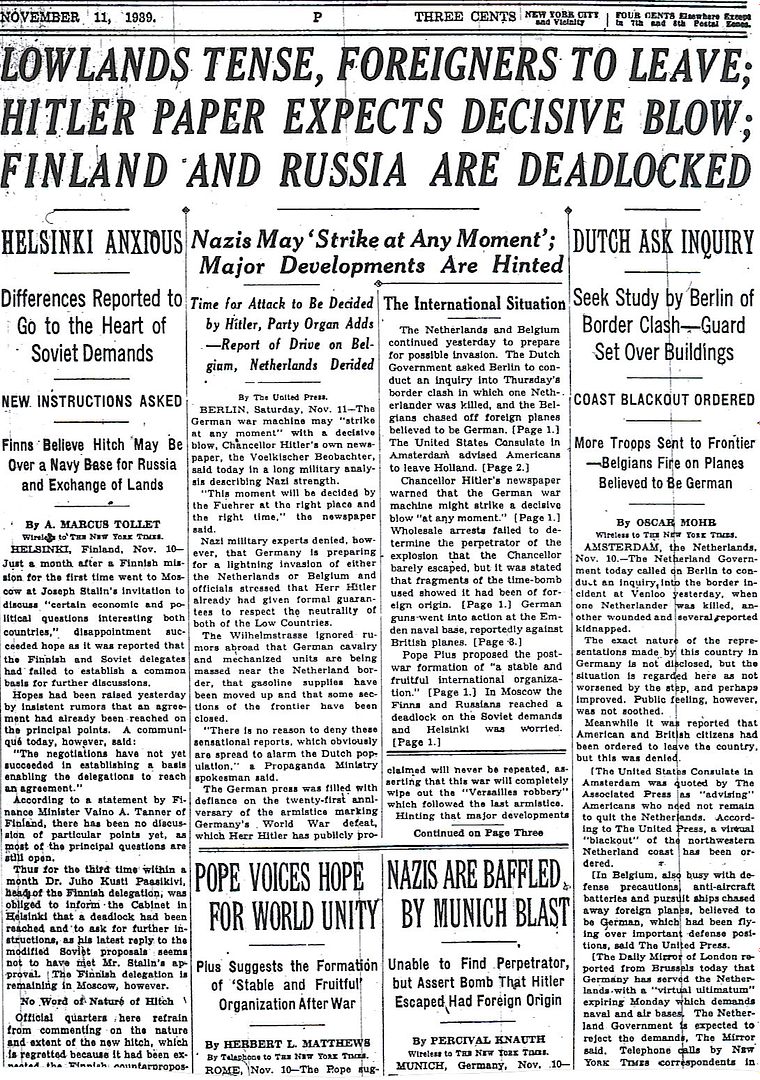
Posted on 11/11/2009 6:34:04 AM PST by Homer_J_Simpson


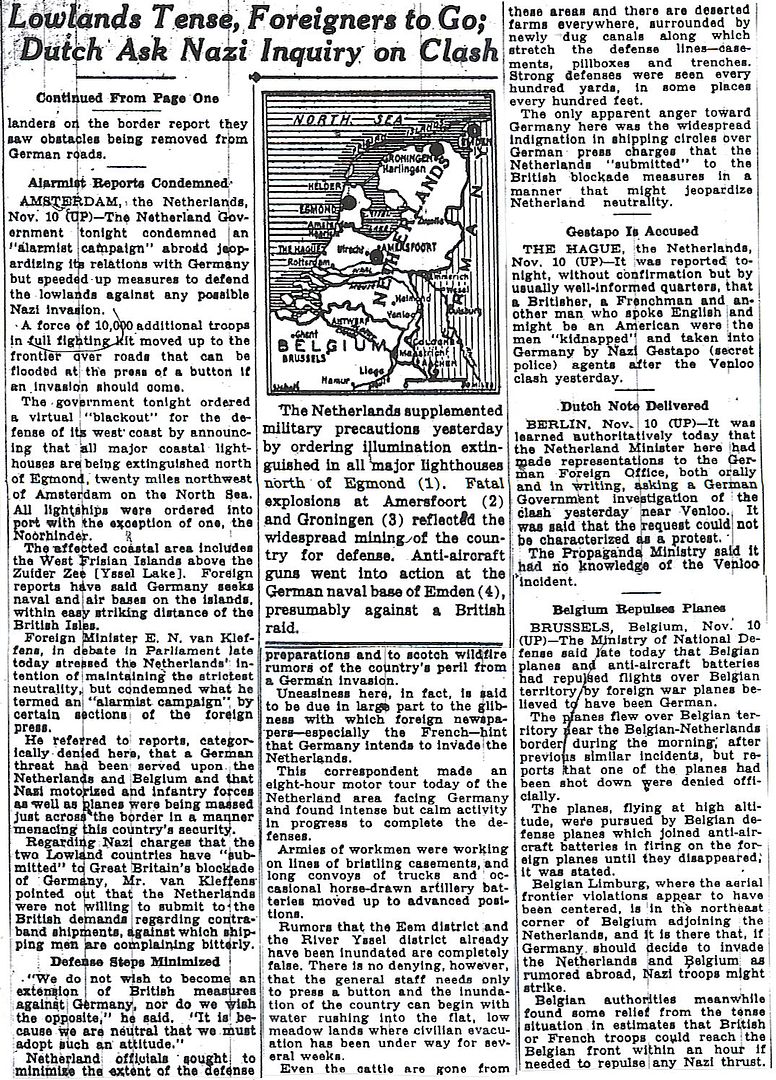
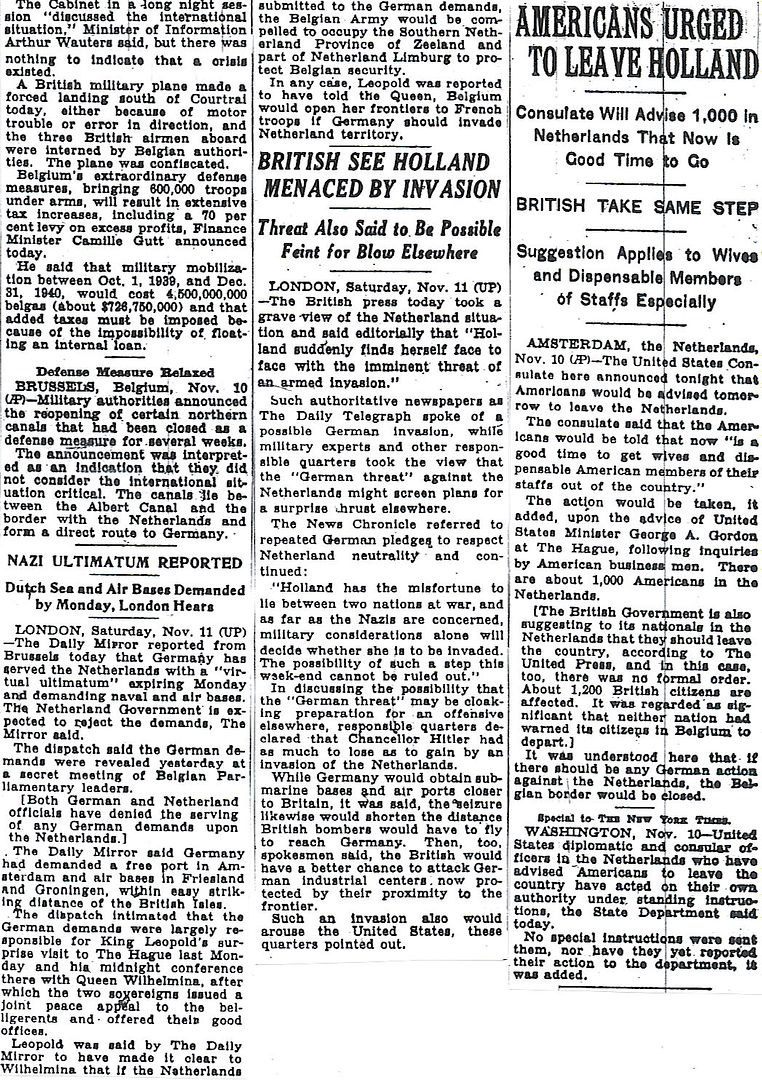
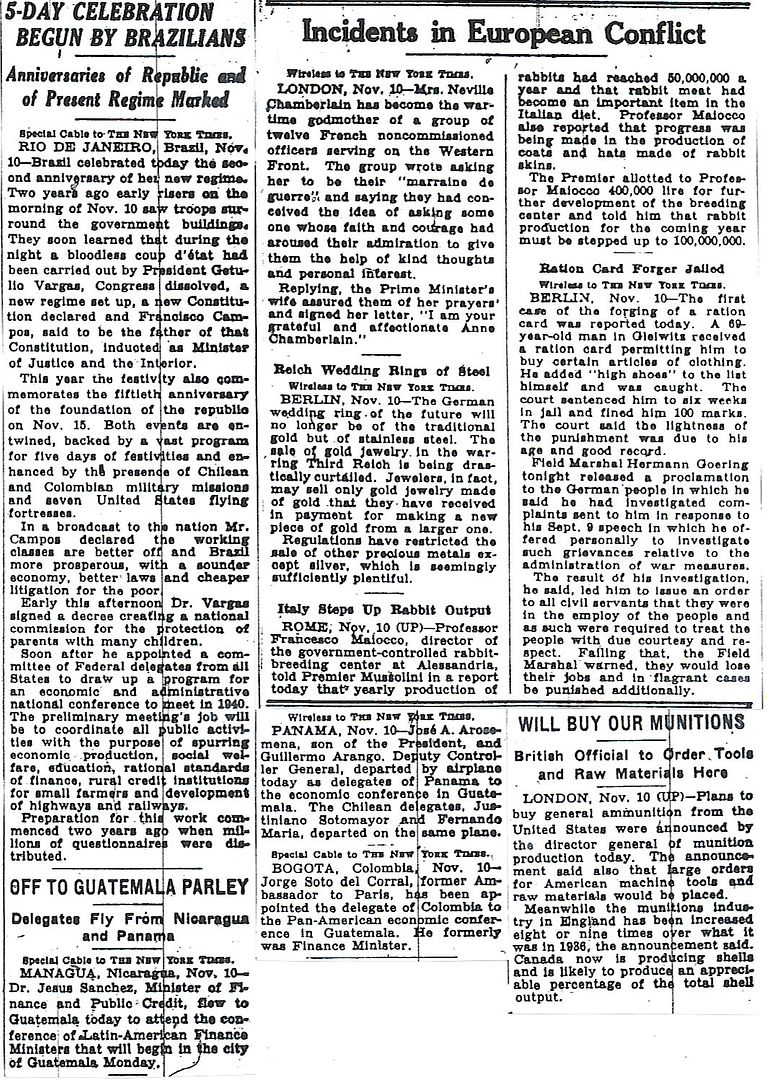
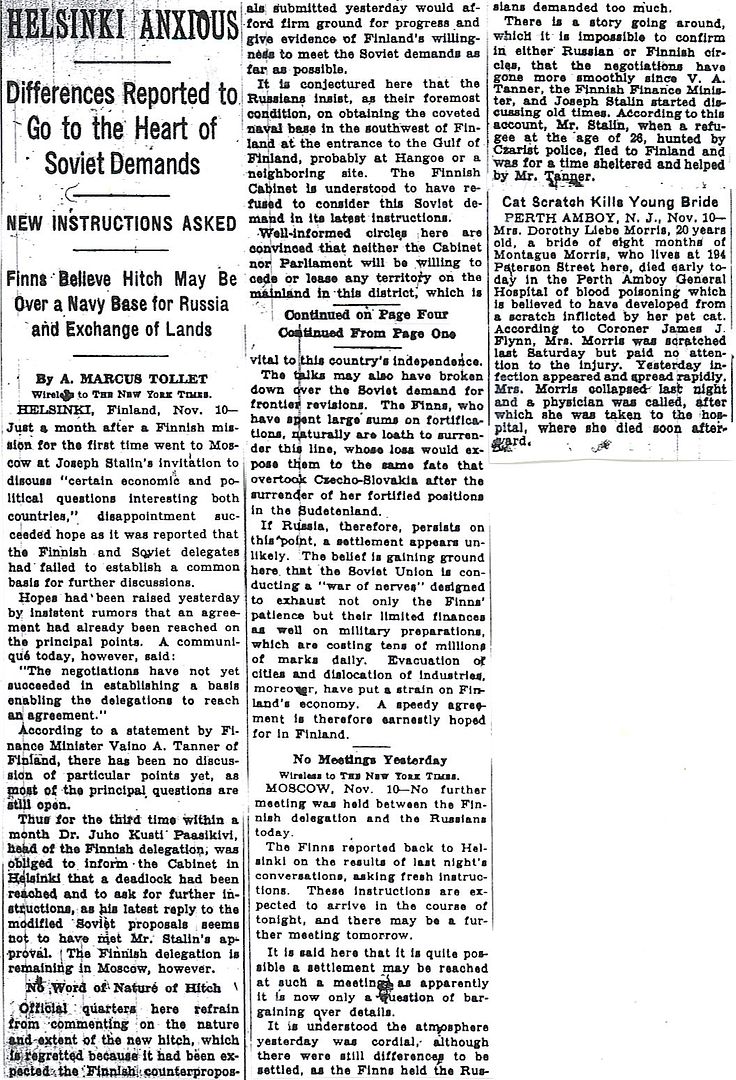
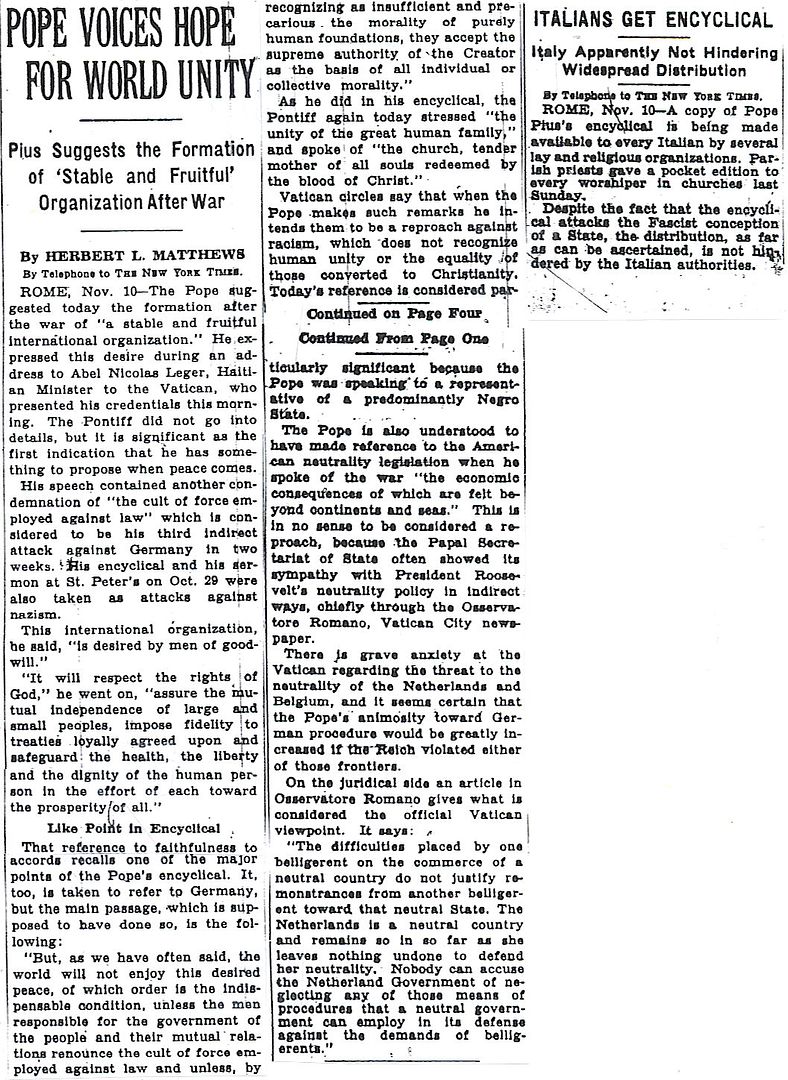
http://www.onwar.com/chrono/1939/nov39/11nov39.htm
Germany will respect the neutrals
Saturday, November 11, 1939 www.onwar.com
In Berlin... The Reich foreign ministry repeats earlier assurances that the neutrality of Holland and Belgium will be respected.
On the Western Front... There is limited activity by German patrols and artillery. The BEF holds Armistice Day services amid the great battlefields of the First World War.
In Britain... Queen Elizabeth broadcasts a message to the women of the Empire, from Buckingham Palace. She says women “have real and vital work to do” and assures women that they are “keeping the Home Front, which will have dangers of its own, stable and strong.”
Naval Events-Saturday, 11 November
On Northern Patrol were two cruisers were between the Orkneys and the Faroes, three cruisers and one AMC between the Faroes and Iceland, and one cruiser and two AMCs in the Denmark Strait. Light cruiser GLASGOW was en route to patrol in the Denmark Strait while light cruiser DIOMEDE was escorting Swedish steamer DROTTNINGHOLM (11, 055grt), which had been intercepted in the Faroes-Iceland patrol, towards Kirkwall.
(In the Admiralty War Diary, the steamer is identified as above. In the Rosyth War Diary, she is identified as Danish steamer MARTIN GOLDSCHMIDT, 2095grt).
DIOMEDE requested a trawler to take over, and armed boarding vessels NORTHERN ISLE and NORTHERN FOAM were dispatched. DIOMEDE lost track of the steamer before they arrived, but armed merchant cruiser CALIFORNIA located her late on the 11th. The trawlers could not make the rendezvous due to bad weather.
_____
Armed merchant cruisers AURANIA and CHITRAL arrived in the Clyde after Northern Patrol duties.
_____
Destroyer MAORI departed Scapa Flow to rendezvous with submarines TRIUMPH and TRIDENT 10 miles due north of the Butt of Lewis for escort. They arrived at Rosyth on the 12th.
_____
Destroyer ZULU searched for a submarine reported NW of Holbourn Head.
_____
Convoy FN.35 departed Southend, escorted by destroyer WOOLSTON and sloops PELICAN and HASTINGS. Destroyers JUNO and JUPITER were at sea as a fighting force for this convoy and for FS.35. Seven steamers became detached from FN.35 and Polish destroyers GROM and BURZA escorted them into the Humber. GROM afterwards returned to Harwich. The convoy arrived at Methil on the 13th, WOOLSTON and PELICAN at Rosyth mid-day, and HASTINGS which had lost touch, two hours later.
_____
Convoy FS.35 departed Methil, escorted by destroyers WALLACE, WHITLEY and sloops STORK and STORK which attacked a submarine contact 9.9 miles off St Abbs Head. The convoy arrived at Southend on the 13th.
_____
Trawler SOUTHWARD HO (204grt) reported a submarine five miles SE of the Tyne. Anti-submarine trawlers OLVINA (425grt) and CAPE COMORIN (504grt) carried out a search and during the night of the 11th/12th, CAPE COMORIN ran aground near the Tyne. She was refloated and repaired.
_____
Destroyers KEITH and BOADICEA were on East Coast patrol. BOADICEA was detached to Harwich to refuel and KEITH was relieved by Polish destroyers BURZA and GROM on the 11th.
_____
Destroyers IMOGEN, ICARUS and IMPULSIVE departed Scapa Flow on anti-submarine patrol and returned the next day.
_____
The Humber Force, consisting of 2nd Cruiser Squadron, the 7th Destroyer Flotilla, and destroyers MASHONA, BEDOUIN, TARTAR, GURKHA of the 4th Flotilla, were placed under direct Admiralty control to counter a possible sea invasion of Holland thought to be due.
Light cruisers GLASGOW, SOUTHAMPTON, AURORA, BELFAST, with MASHONA, TARTAR and GURKHA departed Rosyth on the 11th to join the Humber Force at Immingham. BEDOUIN was delayed three hours and arrived later.
On the 12th, MASHONA, BEDOUIN and TARTAR were relieved by destroyers AFRIDI, MAORI and ZULU, with MASHONA departing Rosyth on the 14th, escorting submarine H.34 and tanker WAR PINDARI to Scapa Flow and Loch Ewe, respectively. BEDOUIN proceeded to Scapa Flow, while TARTAR escorted steamer MARYLYN (4555grt), departing Aberdeen on the 14th for Scapa Flow.
_____
Patrol sloops KINGFISHER and WIDGEON departed Belfast and arrived in the Clyde later the same day.
_____
Light cruiser EMERALD departed Portsmouth with another shipment of gold for Canada, called at Plymouth on the 12th, and arrived at Halifax on the 21st.
_____
Destroyer WIVERN arrived at Chatham after boiler cleaning at Plymouth.
_____
Aircraft carrier ARGUS and destroyer STURDY departed Devonport for Toulon where the carrier could conduct training exercises for new pilots. Destroyer GALLANT departed Portsmouth on the 13th and joined the ships.
STURDY was to carry on and join the local defence destroyer flotilla on the China Station, but was retained in the Mediterranean as attendant destroyer for ARGUS. The three ships arrived at Gibraltar on the 17th with GALLANT leaving on the 17th and reaching Plymouth on the 21st.
_____
Convoys OA.32G, which had departed the Thames on the 8th, and OB.32G, which had departed Liverpool, merged on the 11th as OG.6 with 43 ships. They were escorted by destroyers MACKAY, VIMY, WHIRLWIND, WREN and WAKEFUL from the 8th to 11th, and French destroyers TIGRE and PANTHÈRE from the 11th to 16th, when the convoy arrived at Gibraltar. Anti-submarine trawlers SPANIARD (455grt), TURCOMAN (455grt) and KELT (455grt) were with the convoy from the 11th to 16th.
_____
Heavy cruisers SUSSEX and SHROPSHIRE departed Simonstown and Capetown respectively, to sweep towards St Helena. While departing, SUSSEX was in a minor collision with tanker ATHELPRINCE (8782grt) at Simonstown. The cruisers arrived back on the 23rd.
_____
Battleship RAMILLIES and destroyer DELIGHT departed Port Said to relieve battleship MALAYA and destroyer DARING off Aden.
_____
Light cruiser PENELOPE departed Alexandria on patrol, and arrived at Malta on the 25th.
_____
The 1st Motor Torpedo Boat Flotilla left Malta on the 11th with base ship VULCAN (trawler, 623grt) for Bizerte and Ajaccio, en route to Portsmouth. The Flotilla consisted of the same units it had at the beginning of the war. Destroyer DAINTY followed the flotilla to escort.
MTB.3 and MTB.4 broke down and returned to Malta, were freighted in depot ship WOOLWICH, which departed Malta on the 21st, and later arrived at Portsmouth. DAINTY and seven MTBs reached Bizerte on the 15th and MTB.14, MTB.15, MTB.16, MTB.18 were sent on to Ajaccio.
On the 16th in heavy weather off Sardinia, MTB.6 broke down and was taken in tow by DAINTY. However, she was lost when the ring of the towing spar fractured and DAINTY rammed her. MTB.1 and MTB.19 remained with DAINTY and arrived at Ajaccio before noon on the 19th, after which DAINTY returned to Malta.
Liner FRANCONIA, carrying MTB.2, MTB.5, MTB.17, departed Malta on the 16th escorted by destroyer DUCHESS. The liner was damaged by heavy seas and forced to heave to, but was able to reach Marseilles on the 19th. On the 24th, the flotilla departed Marseilles, travelled up the Rhone River, and was then towed through the canals to the Seine. In the Seine, once again under their own power, they sailed through Paris and out to sea finally arriving at Portsmouth on 6 December. After refitting, the Flotilla was based at Felixstowe and became operational in January 1940.
_____
Light cruiser NEPTUNE departed Freetown on patrol, met depot ship MAIDSTONE, and returned on the 16th to join aircraft carrier ARK ROYAL.
_____
French submarine SIDI FERRUCH arrived at Port of Spain after patrol in the Caribbean
.
.
.
Lie # 29,998,842
“In Berlin... The Reich foreign ministry repeats earlier assurances that the neutrality of Holland and Belgium will be respected.” —November 11, 1939, German Reich Foreign Ministry
.
.
.
Lie # 2,229,998,842
“The American people voted to restore integrity and honesty in Washington, D.C., and the Democrats intend to lead the most honest, most open and most ethical Congress in history.” — November 8, 2006, Nancy Pelosi
.
.
.
You’d think we’d wise up after a while.
A group of interned German steamers escapes from the Port of Vigo in Spain, and attempt to return to Germany.
CORDOBA (4611grt) passed through the Denmark Strait on the 22nd, sighted an armed merchant cruiser but was not seen and arrived at Narvik on the 28th.
LAHNECK (1663grt) successfully passed through the Denmark Strait and arrived at Hamburg on 16 December.
LIVADIA (3094grt) passed through the Iceland-Faroes passage on the 16th, arrived in Honningsvaag on the 27th, and reached Hamburg on 9 December.
LUDOLF OLDENDORFF (1953grt) passing the Iceland-Faroes passage on the 24th was sighted and stopped by light cruiser SHEFFIELD. However, she was able to convince SHEFFIELD she was Danish steamer EDITH and in the confusion following the sinking of the RAWALPINDI, was not questioned further and arrived at Haugesand on 6 December.
PALOS (997grt) passed through the Denmark Strait on the 23rd, and arrived at Hamburg on the 29th.
SEBU (1894grt) passed through the Denmark Strait on the 24th, and arrived at Hamburg on 18 December.
TANGER (1742grt) passed the Iceland-Faroes Passage on the 20th, and arrived at Hamburg on 9 December.
Finally, the last ship of the group, KONSUL HENDRICK FISSER (4458grt) was captured attempting to pass the Iceland-Faroes Passage on the 23rd.
War Diary and War Standing Orders of Commander in Chief, Submarines, Admiral Donitz
11 Novenber, 1939
“Analysis of information on the whereabouts of the British battle fleet shows that it is probably distributed over various places outside the North Sea. The possibilities if mining these places with TMB’s must therefore be considered.
The main difficulties will probably be navigational. It is hardly likely that all these places are under constant strong patrol, or that local defenses are very extensive. The first area to be considered is the Bay of Oban. The battleship Rodney was lying there some time ago.
Information received so far on the effects of the minefields laid by U-boats shows that not all the ships which ran into the fields were sunk. We must therefore try to lay the mines in shallow water and reduce their sensitivity so that they are only exploded by largish ships.”
One of my favorite Royal Navy warships.
http://uboat.net/allies/warships/ship/4428.html
HMS Zulu (F 18)
Destroyer of the Tribal class
Pennant numbers:
L 18 July 1938 - December 1938
F 18 January 1939 - Autumn 1940
G 18 Autumn 1940 - September 1942.
There was always something different about HMS Zulu. Perhaps being launched with boilers and funnels in place makes a happy ship. Perhaps her crew were determined that their ship, alphabetically last, should not be the least in her class. Zulu started as a happy and contented ship and remained so. After completing sea trials, Zulu sailed for the Mediterranean and arrived at Malta on 18 November 1938. There she joined HMS Afridi and the 1st Tribal Destroyer Flotilla. The 1939 spring exercises at Gibraltar were followed by independent cruising in the Western Mediterranean.
When war broke out, Zulu joined up with her sister ships to begin convoy escort duties and contraband control. In February 1940, she developed turbine trouble and had to be dry-docked for repairs at Leigh, England. She was also degaussed and returned to service on 9 March. Zulu was given a part to play in Plan R4 - the projected landing in Norway that would forestall German reaction to Operation Wilder. As it happened, Germany invaded Norway first and the Home Fleet put to sea.
In early 1941, HMS Cossack, HMS Maori, HMS Sikh and HMS Zulu were mainly employed in escorting convoys in and out of the Western approaches. They were escorting such a convoy on 26th May when they were ordered to join the Commander-in-Chief (C-in-C). The 4th Destroyer Flotilla thus shared in the destruction of the German battleship Bismarck. After the excitement of the chase, the 4th D.F. returned to Home Fleet work and Western Approaches escort duties.
In June 1941, Zulu sailed for Falmouth, England to begin her refit. Her after funnel was cut down and her mainmast was fitted with a high frequency direction finding (Huff-Duff) outfit. Two, single 2 pounder guns were mounted on the bridge wings. Radar was installed and the depth charge throwers were re-located. The refit was completed by July.
For the better part of 1942, Zulu was attached to Force H at Gibraltar, striking against Axis supply convoys. HMS Zulu (Cdr. Richard Taylor White, DSO and Bar, RN) and HMS Sikh’s final operation together was the attack on Tobruk, Libya on 13/14th September 1942. As a result of shelling from coastal batteries, Zulu was hit but she could still make 30 knots. Her crew had been at full watch since dusk on the 13th and daylight on the 14th did not bring any rest. In spite of surviving multiple bomb attacks during that day, Zulu was mortally wounded at 1600hours. A bomb from an enemy aircraft had pierced her side and exploded in the engine room, thus flooding it along with #3 Boiler Room and the Gear Room. She stopped dead in the water and settled two feet deeper. HMS Croome came along side to take off any remaining personnel except for a towing party. Zulu was taken in tow by HMS Hursley. By 1900hours, and only a hundred miles from Alexandria, Egypt, she was sinking fast. The towing party was rescued after a strafing pass by an enemy aircraft. Suddenly, Zulu rolled to starboard and sank in position 32º00’N, 28º56’E. In both attacks, twelve men had been killed, twenty seven went missing and one was wounded.
Commanding Officers:
Cdr. John Stuart Crawford, RN
Promoted to Capt. on 31 December 1940
DSO awarded on 24 September 1940
15 February 1938 - 14 January 1941
Cdr. Harry Robert Graham, DSO, RN
DSC awarded on 10 October 1941
14 January 1941 - 28 April 1942
Cdr. Richard Taylor White, DSO and Bar, RN
28 April 1942 - 14 September 1942
Noteable events involving Zulu include:
23 Nov 1939
Sinking of the armed merchant cruiser HMS Rawalpindi;
Around midday on 21 November 1939 the German battlecruisers Scharnhorst and Gneisenau, escorted by the light cruisers Köln and Leipzig and the destroyers Z 11 / Bernd von Arnim, Z 12 / Erich Giese and Z 20 / Karl Galster, departed Wilhelmshaven for a raid into the North Atlantic, this was to relieve the pressure of the pocket battleship Admiral Graf Spee operating in the South Atlantic. Late on the 21st the escorts left the battlecruisers.
Just after 1500 hours on 23 November the British armed merchant cruiser HMS Rawalpindi (Capt. E.C. Kennedy, (retired), RN) sighted the Scharnhorst. Rawalpindi was part of the British Northern Patrol and was stationed south-east of Iceland in the Iceland-Faroer gap. Captain Kennedy tried to outrun the German ship and reported to the Admiralty that he sighted the German pocket battleship Deutschland, still believed to be operating in the North Atlantic. Just after 1600 hours, Rawalpindi came within range of the Scharnhorst and was quickly reduced to a flaming wreck. During this engagement Scharnhorst was hit by a 6” shell from Rawalpindi causing only light damage. Scharnhorst and Gneisenau together picked up 27 survivors from Rawalpindi. Rawalpindi finally sank around 2000 hours.
The British light cruiser HMS Newcastle (Capt J. Figgins, RN), that was also part of the Northern Patrol, picked up Rawalpindi’s signal and closed the scene. She sighted the Gneisenau but the Germans managed to escape in the fog.
The Admiralty also thought the ship sighted by Rawalpindi and Newcastle was the Deutschland that was trying to return to Germany. In response to the sighting and destruction of the Rawalpindi the Admiralty took immediate action; The battleships HMS Nelson (Capt. G.J.A. Miles, RN with Admiral Forbes aboard) HMS Rodney (Capt. F.H.G. Dalrymple-Hamilton, RN) and the heavy cruiser HMS Devonshire (Capt. J.M. Mansfield, DSC, RN) escorted by the destroyers HMS Faulknor (Capt. C.S. Daniel, RN), HMS Fame (Cdr. P.N. Walter, RN), HMS Firedrake (Lt.Cdr. S.H. Norris, RN), HMS Foresight (Lt.Cdr. G.T. Lambert, RN), HMS Forester (Lt.Cdr. E.B. Tancock, RN), HMS Fortune (Cdr. E.A. Gibbs, RN) and HMS Fury (Cdr. G.F. Burghard, RN) departed the Clyde to patrol of Norway to cut of the way to Germany for the Deutschland.
The light cruisers HMS Southampton (Capt. F.W.H. Jeans, CVO, RN), HMS Edinburgh (Capt. F.C. Bradley, RN) and HMS Aurora (Capt. G.B. Middleton, RN) escorted by the destroyers HMS Afridi (Capt. G.H. Creswell, DSC, RN), HMS Gurkha (Cdr. F.R. Parham, RN), HMS Bedouin (Cdr. J.A. McCoy, RN), HMS Kingston (Lt.Cdr. P. Somerville, RN) and HMS Isis (Cdr. J.C. Clouston, RN) departed Rosyth to patrol between the Orkney and Shetland islands.
Light cruiser HMS Sheffield (Capt. E. de F. Renouf, CVO, RN) was sent from Loch Ewe to the last known position of the German ship(s).
On northern patrol, south of the Faroers were the light cruisers HMS Caledon (Capt. C.P. Clark, RN), HMS Cardiff (Capt. P.K. Enright, RN) and HMS Colombo (Capt. R.J.R. Scott, RN). These were joined by HMS Dunedin (Capt. C.E. Lambe, CVO, RN) and HMS Diomede (Capt. E.B.C. Dicken, RN).
Of the ships of the Denmark strait patrol, the heavy cruisers HMS Suffolk (Capt. J.W. Durnford, RN) and HMS Norfolk (Capt. A.G.B. Wilson, MVO, DSO, RN) were ordered to proceed to the Bill Bailey Bank (to the south-west of the Faroers)
The light cruiser HMS Glasgow (Capt. F.H. Pegram, RN) escorted by the destroyers HMS Maori (Cdr. G.N. Brewer, RN) and HMS Zulu (Cdr. J.S. Crawford,RN) were already at sea patrolling north-east of the Shetlands were to be joined by the destroyers HMS Inglefield (Capt. P. Todd, RN), HMS Imperial (Lt.Cdr. C.A.de W. Kitcat, RN), HMS Impulsive (Lt.Cdr. W.S. Thomas, RN) and HMS Imogen (Cdr. E.B.K. Stevens, RN) .
Dispite the British effort to intercept the German ships, both German battlecruisers returned to Wilhelmshaven on the 27th.
25 May 1941
The 4th Destroyer Flotilla comprising the British destroyers HMS Cossack (Capt. P.L. Vian, DSO, RN), HMS Maori (Cdr. H.T. Armstrong, DSO, RN), HMS Sikh (Cdr. G.H. Stokes, RN), HMS Zulu (Cdr. H.R. Graham, DSO, RN) and the Polish destroyer Piorun (Cdr. E. Plawski, Polish Navy) was escorting convoy WS-8B when they recieved an order to leave the convoy and take part in the hunt for the German battleship Bismarck.
4 Aug 1942
The German submarine U-372 was sunk in the Mediterranean south-west of Haifa, in position 32º28’N, 34º37’E, by depth charges from the British destroyers HMS Sikh Capt. St.J.A. Micklethwait, DSO and Bar, RN) and HMS Zulu (Cdr. R.T. White, DSO and Bar, RN) and the British escort destroyers HMS Croome (Lt.Cdr. R.C. Egan, RN) and HMS Tetcott (Lt. R.H. Rycroft, RN) and by depth charges from a British Wellington aircraft (221 Sqdn.). (see map)
WAR NOTES-November 11, 1939
* French Colonel Charles de Gaulle urges general headquarters that French tanks be formed into armored divisions rather than be dispersed as infantry supports. His ideas are rejected.
* In England, Dr. R.V. Jones submits The Hitler Waffe report, listing seven possible secret German weapons, with #5 being long-range guns and rockets.
* The Belgian Army cancels military leaves.
* Belgian police along the French border receive orders to clear roads to allow for French forces entering into Belgium.
http://www.islandnet.com/~kpolsson/ww2hist/ww21939oct.htm
Holocaust Project Timeline: November 11, 1939:
As punishment for reprisals to Polish aggression, three boys from Zielonka, Poland are taken to the nearby woods and shot.
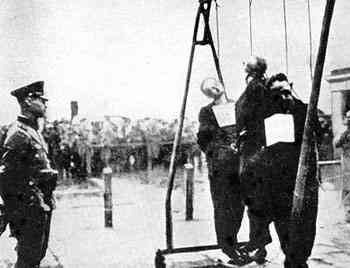 The Lodz intelligentsia and clergy representatives, who did not accept subordination to the occupiers, as well as the Jewish Council of Elders appointed a few days earlier, were arrested. After Rumkowski's intervention, the Nazis released 10 councellors. The other 20 persons were shot or deported to concentration camps.
The Lodz intelligentsia and clergy representatives, who did not accept subordination to the occupiers, as well as the Jewish Council of Elders appointed a few days earlier, were arrested. After Rumkowski's intervention, the Nazis released 10 councellors. The other 20 persons were shot or deported to concentration camps.
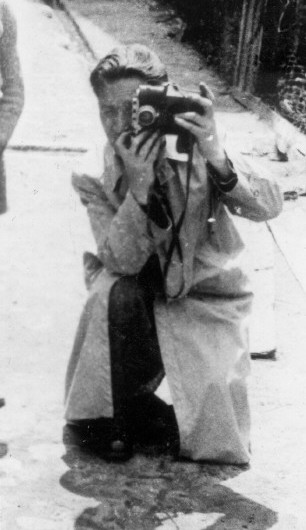 When the Germans finally learned of his activities during the final liquidation of the Lodz Ghetto, Mendel was sent to the Konigs Wusterhausen labour camp, in the Reich where he secretly continued photographing, but not developing and printing.
When the Germans finally learned of his activities during the final liquidation of the Lodz Ghetto, Mendel was sent to the Konigs Wusterhausen labour camp, in the Reich where he secretly continued photographing, but not developing and printing. 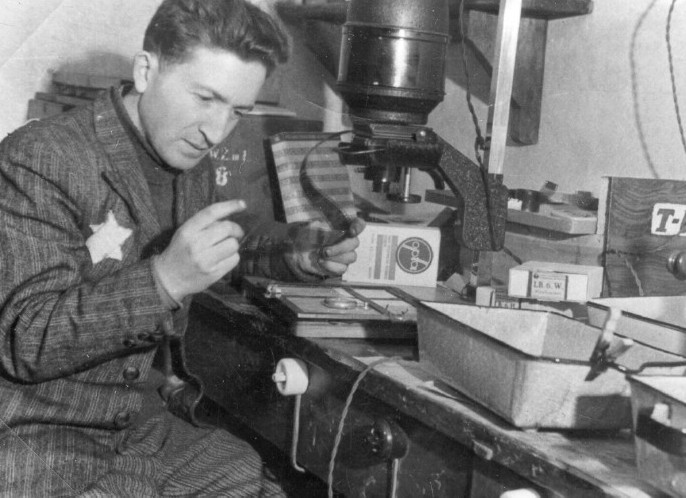 When, the war front advanced and came closer, and the prisoners of the camp were taken out on the death march, Grossman collapsed and died with his camera on him. The negatives of his photographs hidden by him in the ghetto, were found by Mendel’s sister and sent to Israel, but most of them were lost during the War of Independence, when Egyptian troops captured the Nitzanim kibbutz.
When, the war front advanced and came closer, and the prisoners of the camp were taken out on the death march, Grossman collapsed and died with his camera on him. The negatives of his photographs hidden by him in the ghetto, were found by Mendel’s sister and sent to Israel, but most of them were lost during the War of Independence, when Egyptian troops captured the Nitzanim kibbutz. 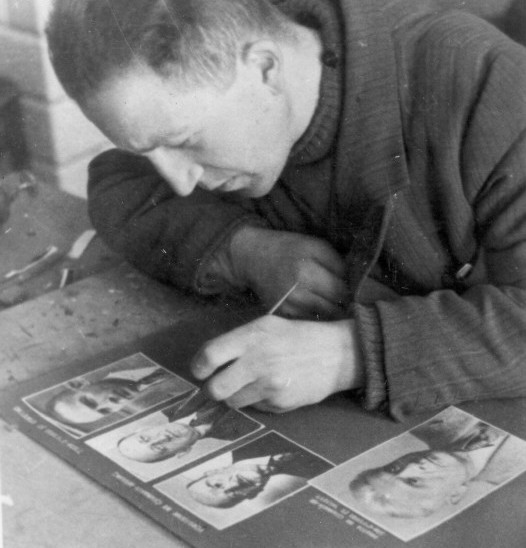 One of Mendel’s closest friends Nahman Zonabend remained in the Lodz ghetto until its liberation. Although the Nazis kept him under constant surveillance, he succeeded in saving the archives of the Judenrat, and he concealed the documentary treasure, including some of Mendel’s photographs, at the bottom of a well. After the war this material was taken out of Poland. The archives were collected and are now housed in the Museum of Holocaust and Resistance at the Ghetto Fighters House in Kibbutz Lohamei Hagetaot Israel.
One of Mendel’s closest friends Nahman Zonabend remained in the Lodz ghetto until its liberation. Although the Nazis kept him under constant surveillance, he succeeded in saving the archives of the Judenrat, and he concealed the documentary treasure, including some of Mendel’s photographs, at the bottom of a well. After the war this material was taken out of Poland. The archives were collected and are now housed in the Museum of Holocaust and Resistance at the Ghetto Fighters House in Kibbutz Lohamei Hagetaot Israel.
November 11, 1939:
U.S. freighter Nishmaha is detained by British authorities at Gibraltar (see 17 November);
freighter Yaka is detained by the British and her cargo examined
Meanwhile, on the college football front, the USC Trojans will be celebrating Armistice Day at the Los Angeles Memorial Coliseum, where they will be hosting the Stanford Indians. Coach Howard Jones’ resurgent Thundering Herd, who are riding an eight-game unbeaten streak, will likely roll over Coach Claude Thornhill’s hapless boys from Palo Alto, who have yet to win a game this year.
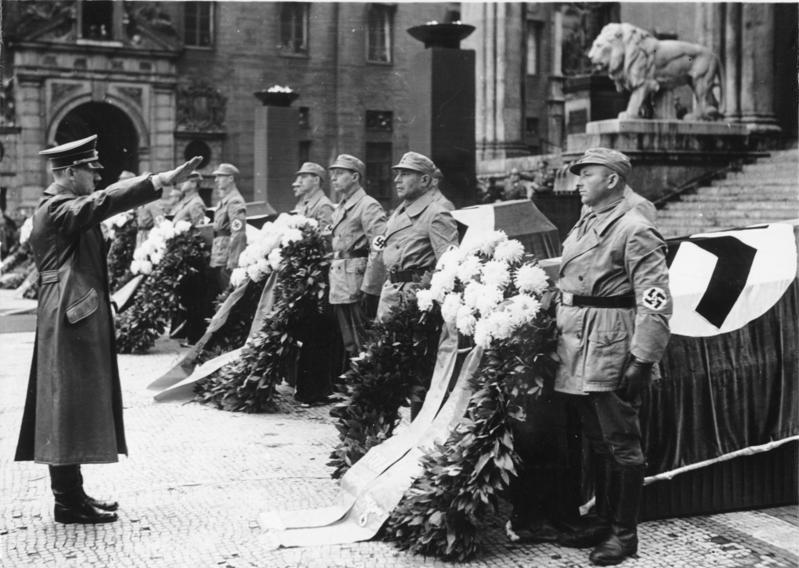 Hitler salutes the caskets of 7 seven Party Members killed in the Biirgerbraukeller bombing of a few days ago. Notice that each is attended by a NAZI Party member. From the Bundesarchiv
Hitler salutes the caskets of 7 seven Party Members killed in the Biirgerbraukeller bombing of a few days ago. Notice that each is attended by a NAZI Party member. From the Bundesarchiv
11/11/1939
-The district of Lodz in Poland, will be incorporated into the newly created Reichsgau posession.
- In an official ceremony, the seven dead of the bombing at the Munich Biirgerbraukeller of 8 November are buried in Munich
-Fuhrer and Reich Chancellor Adolf Hitler congratulates the Italian king Victor Emmanuel III on his 70th Birthday.
-In several parts of occupied Poland, posters commemorating the founding of the Polish Republic on 11 November 1918 appear.
Governor-General Hans Frank directs that “in every house, where a poster is found, the occupants will be shot”.
-In Berlin, The National German Teacher’s Conference meets. The issue is the planned reopening of all schools of the Empire in the spring trimester of 1940.
 My French sucks.. Anybody care to translate?
My French sucks.. Anybody care to translate?
"In the Supplement: A map of the French-German Front.
In living color."
It is inspiring to learn about ordinary people, like Mendel Grossman, who respond to crisis with such courage and character. It makes me yearn to travel to Israel to see his surviving photos and pay him homage.
 Ernst was a professional enlisted soldier in the Wehrmacht, beginning the war 8th Regiment, 38th Infantry Division. He would participate in all major Campaigns, starting in Poland, the the Invasion of France, And the Soviet Union, fighting until the very end of the War. He would demobilize in the field, and return home, never having been a POW. An amazing feat, considering the death rate of enlisted soldiers that were in the Army on Sept, 1 1939 was over 90% by War's end. (Officer's was almost 60%)
Ernst was a professional enlisted soldier in the Wehrmacht, beginning the war 8th Regiment, 38th Infantry Division. He would participate in all major Campaigns, starting in Poland, the the Invasion of France, And the Soviet Union, fighting until the very end of the War. He would demobilize in the field, and return home, never having been a POW. An amazing feat, considering the death rate of enlisted soldiers that were in the Army on Sept, 1 1939 was over 90% by War's end. (Officer's was almost 60%)  They donated over 1800 letters to the "Feldpost Projekt", which is like our "Letters Home" rememberance Programs. http://www.museumsstiftung.de/feldpost/brief.html?action=detail&what=letter&id=1283
They donated over 1800 letters to the "Feldpost Projekt", which is like our "Letters Home" rememberance Programs. http://www.museumsstiftung.de/feldpost/brief.html?action=detail&what=letter&id=1283
Disclaimer: Opinions posted on Free Republic are those of the individual posters and do not necessarily represent the opinion of Free Republic or its management. All materials posted herein are protected by copyright law and the exemption for fair use of copyrighted works.